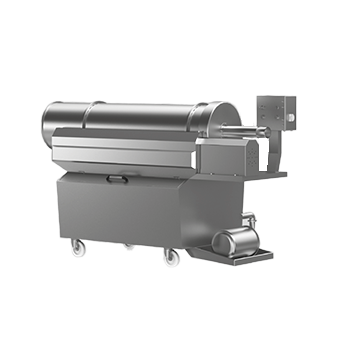The cheese vat, a primary apparatus in cheese manufacturing, serves the purpose of warming the milk it receives. Once the desired temperature is achieved, it facilitates the uniform blending of yeast and additional ingredients through an internal mixer.
Subsequently, the fermented milk undergoes a process where specialized cutting blades, adept at creating cube-shaped incisions, are employed. As the clot matures, these incisions evolve into curds.
Technical Specifications:
- The cheese vat’s mixers operate bidirectionally, functioning as mixers when turned right and as cutters when turned left. One of the cutting knives is designed vertically, while the other is horizontal. The guided bearing is established using a reducer and a hitch transfer mechanism.
- Within the cheese vat’s body, a dimple plate (heating wall) sheet is positioned. Heating is accomplished by steam circulating within this heating wall. The steam’s test pressure within the wall reaches 3 bar, while the applied pressure is set at 1.5 bar. The tank body features a pneumatic valve for steam inlet and a steam trap known as a steam trap.
- The tank is constructed using a box profile on the platform, with a flanged connection securing it to the platform. Additionally, there is a mobile platform designed for operator access, constructed from stainless steel sheeting with a specialized non-slip surface.
- At the product outlet of the tank, there is a practical and convenient large-scale hygienic stainless butterfly valve.
- The tank is equipped with a manhole cover and an embedded safety sensor grid system. When the grid is in the open position, it ensures safety by preventing the blades from operating.
- A ventilation shaft is incorporated into the tank, featuring a perforated sheet inside to prevent foreign objects from escaping.
- Two rotating CIP (Cleaning-in-Place) balls are present within the cheese vat.
- In high-capacity tanks, an evacuation system is integrated, operating with a vacuum pump composed of perforated sheets to facilitate whey removal. This system automatically immerses into the curd after the mixing process, utilizing the vacuum pump to extract whey from the tank.
- During the curd emptying process, a pneumatic piston is employed to tilt the tank body forward, ensuring no residual product remains inside.
Electrical Control Panel:
- The electrical control panel for the cheese vat boasts an IP 65 protection rating and is affixed to the platform. Mixer operation is regulated through the use of an inverter.
- Depending on customer preferences, control can be implemented via PID (Proportional-Integral-Derivative) control to satisfy some customers, or alternatively, PLC (Programmable Logic Controller) control can be employed in response to the preferences of other customers.
- For tanks under PLC control, there is the flexibility to opt for prescription processes and select automatic control procedures as desired.


